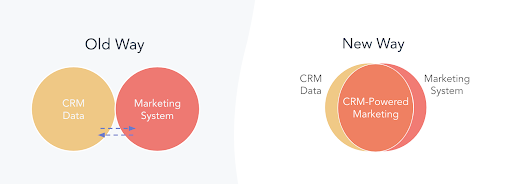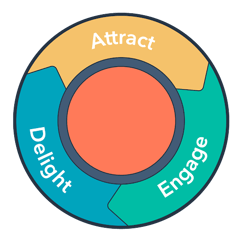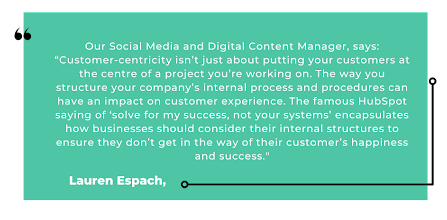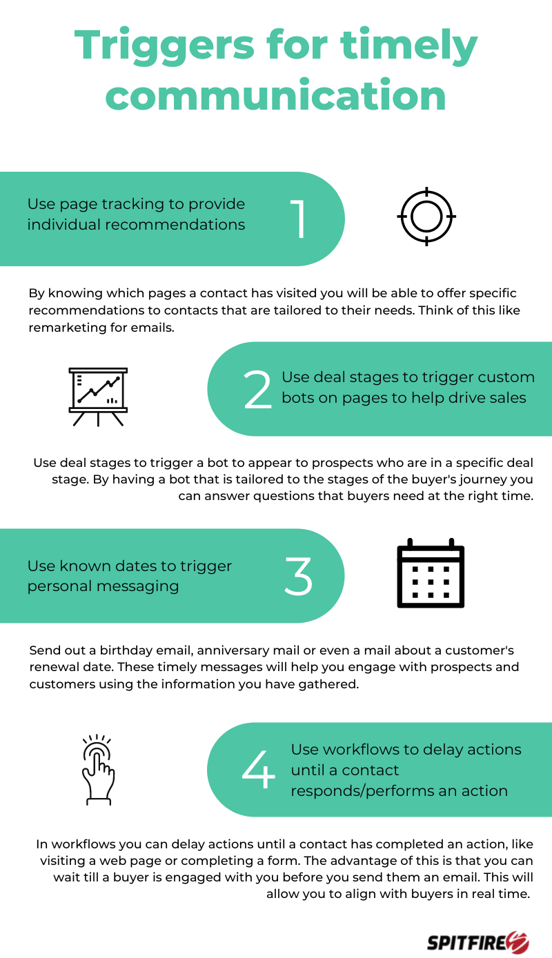How to maximise your HubSpot
Our CRM experts want to help you get the absolute most from HubSpot’s free CRM.
12 May 2022
|
This guide explores and explains how to harness the power of your data and turn your CRM into a revenue-generating growth machine. |
This guide explores and explains how to harness the power of your data and turn your CRM into a revenue-generating growth machine.
CRM is the cost of entry into a modern market: try running a business without one. But a CRM is more than just a digital filing cabinet. It’s a way for you to access, understand, and monetise a goldmine already at your fingertips: customer data.
Data on its own is useless if you don’t know what to do with it. For data to be effective, it needs to be collected, stored, and harnessed in such a way it becomes valuable with minimal maintenance.
For example, having all the names of anybody showing interest in your business over the last eighteen months can be helpful.
But how about knowing who was just browsing, who is ready to buy, or even who is ready to buy AND checked two or three other boxes critical for making a sale?
By better understanding your data and working smart, you can ensure the right messaging gets to the right people at the right time without labour-intensive or prospect-annoying processes. Targeting has also become more sophisticated, meaning that ads are now less interruptive and more informative — so sophisticated, in fact, that we now take for granted the quality of the ads we get served in our Instagram feeds and YouTube videos.
When it comes to how to run your CRM ,Spitfire Inbound takes great pride in how we help our clients. Jacques Le Roux had this to say about how Spitfire utilises HubSpot’s CRM -The Spitfire Inbound team has been phenomenal in managing a new CRM and CRM migration project. Their CEO and senior management involvement, relationship management, project monitoring and control have been superb. A very competent and capable company to have on your CRM side."
Contemporary digital marketing has changed from its first inception 20 years ago. GDPR, POPI, savvy prospects, and even huge corporations like Apple redefining data mining have all had a profound impact.
Sound familiar?

You probably even still see some of them. And we’re not talking about the occasional ‘Hi {first name}’ greeting mistake every marketer dreads sending. We’re talking about the data-scraping, privacy-invading, industry-shaming practices that gave us all a bad name.
Any company relying on these practices today would seem ancient by comparison. But the uncomfortable truth is many businesses STILL market like this. We bet you’ve even had one this week.
But why?
Malicious intent? Avarice? Lack of caring?
In most cases, it’s none of the above. It’s the opposite. Many companies are so excited to get their message out there, they forget the blend of science and craft that comes together to create great marketing. They forget they sit on a goldmine of prospect data offering powerful insights into behaviour, predilections, and desire.
Say hello to the Customer Relationship Management (CRM) system.
A CRM is a system that holds the data of your customer. It can be as simple as a spreadsheet or as powerful as a constantly evolving AI single source of truth. And when used correctly, a CRM has the power to drive more revenue and delight prospects at every stage of the buying journey.

-4.png?width=512&name=unnamed%20(1)-4.png)
The marketers who get ahead today are hyper-focused on the customer experience. Experience-driven marketing puts your customers at the center of everything you do as a marketer.
It's a major reason why HubSpot has adopted the flywheel. When focused on the customer experience, marketing attracts and feeds into sales. Sales engages and feeds into service. Service delights and feeds back into marketing. And all of this is only possible when the customer is at the center, managed by a CRM.

Discover what putting your customer at the center of the flywheel really means here.


Leveraging your CRM is the secret to experience-driven marketing. Experience driven marketing isn't just a buzzword–it's your secret to growth. Forrester research found that companies who said they were focused on experience grew 40% faster and increased customer lifetime value by more than 60% versus those who weren't.
Very few marketers have all of their tools and tactics tightly integrated into a CRM–which often leads to disjointed customer experiences, siloed data, and an inability to know what's working.
This is why we're investing so much effort in tightly integrating HubSpot's Marketing Hub with the CRM–to give your team a unified view of the customer experience, which allows you to create truly personalised experiences across all channels, and to help you properly measure your success as a marketer.
Rooting your marketing in a CRM also lets you create personalised experiences across every channel. Personalisation continues to be the holy grail for delivering a great experience. In this hyper-competitive environment, it's harder than ever to win attention–and we all know that the more you personalise, the greater your chances are of being noticed.
What does real personalisation look like to me? Real personalisation is when the content on your site changes, recommending content that your visitor hasn't read yet. Or when that visitor has shown interest in one topic, so you show them an offer that's related. Or when you have CTAs for customers and different ones for prospects. Or when the chat bot on your site remembers not only their name, but who their sales rep is. All of this is possible through CRM-driven marketing.
The average consumer is bombarded by promotional messaging and sees anywhere between 5000-1000 advertisements per day.
Think about the last time you were relaxing and browsing on your phone, maybe doing a bit of online shopping, checking in on social media, reading the news. How many irrelevant adverts did you see?
“Today only - 50% of all organic aloe vera & chilli peanut butter cups!”
“Door, doors, doors! Get your doors from Acme doors!! Big doors, small prices!”
“Crypto, something or other.”
We bet this week alone you’ve closed down at least one web page because the advertising ruined the online experience for you. But there’s a bigger danger for marketers lurking in the internet shadows than angry prospects. Something much scarier… Apathy!
When your consumer doesn’t feel like your messaging has direct relevance to their life at that moment, they’ll tune out. This is why a CRM is vital to modern marketing. If you don’t understand your customer, you can’t give them the content they need when they need it in a way that works for them.
But the good news is you already have the answer to the problem in your marketing arsenal–the data in your CRM. From that data, you can isolate specific groups of customers by wants, needs, and readiness to buy.

Use HubSpot lists to segment your database
Lists are a great way to isolate segments of your database by any data point you hold. It can be contacted by (who they are) company (where they work) or activity (what they’re doing) focussed and they can even constantly update to suit changing data fields in real-time.
In minutes, you can build a list of all contacts in the third month of their current contract–would they benefit from a useful upsell to complement their existing package?
How about targeting every prospect that’s visited your pricing web page more than once in the last 30 days by sending them a discount code?
Obviously, the same messaging isn't going to work on both of those two groups. But with a small amount of thought, each will get messaging they’re likely to welcome because it solves a specific problem they have.
Learn more about HubSpot Marketing Contacts and how they work here.
Manually tracked custom behavioural events enable you to define and track events that are unique to your business. Custom behavioural events can be tied to contact properties, which you can then use across HubSpot's tools. Manually tracked events use the analytics API, and require a developer to set up.
This is a tool available in HubSpot Marketing Hub Enterprise that allows you to track more advanced analytics on your website or from external third-party apps to gain richer context about the full customer journey.
Learn how this tool works in this article>>
Every buyer for every product must pass through the three key buying stages of Awareness, Consideration, and Decision.
But depending on your product or service, those stages often vary. A thirsty person on a hot day will travel from Awareness to Decision about buying a cold drink faster than a Project Manager looking at new forecasting software for a global Saas business. One is made in minutes, the other could be months.
Although, while the journey may change, one fundamental remains consistent throughout: consumers need specific buying stage-specific content before they can make a decision.
Think about it–before a Project Manager becomes aware your forecasting software even exists, they first need to either experience or recognise they have a problem: the pain caused by poor planning tools. `Then, with a problem to solve, they will look for a solution–which could be a number of options ranging from integrating a new tool right through outsourcing the entire problem.
Build Campaign triggers that are linked to the Buyer's Journey using HubSpot
Consider the below content that was created for buyers at each stage of the journey, triggering emails and messages for the prospect that are linked to where they find themselves in the buyer’s journey will ensure that content is relevant to their needs. Put yourself in the buyer’s shoes and ask yourself what they need at each stage of their journey to purchase.
Awareness:
Blog: Why Project Managers never have enough hours in the day
Consideration:
Guide: 10 ways to become a more effective Project Manager.
Decision:
Case study - why company X chose our technology to solve their forecasting problem
By labelling prospects in your CRM depending on their customer journey, you can ensure they see suitable messaging for their journey. Like you’re probably unlikely to propose marriage on a first date, you also don’t want to bombard a prospect with technical data when they’ve only just discovered they have a problem. Keep sending well timed, useful pieces of information like a small trail of breadcrumbs that draw the buyer in rather than forcing your product on them too soon.
By segmenting your audience, you can ensure they receive relevant, contextually relevant sales messaging to nurture prospects and improve convention rates.
Use HubSpot Smart Content to Contextualise your messaging at scale
HubSpot Smart content allows you to create different content based on a set of rules. Your emails, landing pages, and CTAs can display differently depending on what is known about a prospect or contact.
For example, rather than taking time to manually send context-specific content to prospects, you can adapt your HubSpot pages to react to their needs instead. You can use the data in your CRM to show Awareness, Consideration, or Decision-related content depending on their needs. Allowing you to tailor content to the stage of the buyers’ journey.
By understanding which prospects need to see your messaging, you reduce admin, boost conversion rates, and drive more revenue with less effort.
Yes, you can use HubSpot to personalise sales messaging on any standard or custom properties (the various data points you collect on contacts).
But effective personalisation doesn’t just mean greeting somebody through email by name. It may have been disruptive fifteen years ago, but the modern consumer is both tech and data-savvy.
Modern personalisation means sending relevant messaging in a timely fashion using the right language, tone, and subject matter.
Imagine this: receiving an email greeting you by name. Nice, but you’ve already had four others doing the same that morning alone. You can spot an automated email by now.
But what about four weeks before the renewal for your company-wide HR software is up for review, you receive a timely message specific to your HR management problem?
The power of personalisation can be shown by the following example: You’ve started a small business in the last 6 months and you receive a persuasive message from an invoice management software vendor on the perils of not completing your tax returns in time?
You want your prospects to feel a sense of serendipity. Ultimately we know it was effective CRM management because you created a HubSpot workflow to message either HR managers one month before their next renewal date or small business owners who’ve set up shop in the last year. But prospects will feel a connection with your brand because the message is aimed at their needs at the right time.
Where contextualising ends and personalisation starts can be a grey area, so it’s probably easier to think of it like this:
.png?width=541&name=Segmentation%20(3).png)
Contextualisation ensures you don’t torpedo a conversion by going too hard too soon, but personalisation ensures the prospect feels you’re speaking directly to them at the time they’re most likely to want to hear your message.
Contextual communications should be personal without being too intensely personal that it comes across as overbearing. Clients want personalised information that feels helpful and offers value when they need it.
Use custom properties to gather company-specific information on your leads
HubSpot comes ready-packed with a host of data points you can collect on each prospect. Ranging from name and address right through to how many emails they’ve opened, HubSpot can help you build a better understanding of both groups and individuals.
But because HubSpot has to cater for everything from Saas consultancies to animal feed suppliers, we’re limited in the universal properties we build. Not every customer is going to need the average weight of a Nebraskan dairy herd, right?
But with custom properties, you can build bespoke data points specific to your needs.
As long as you keep your CRM data clean and easy to access, you’ll be able to drive more sales and delight more customers.
Segmenting your audience means you can narrow down exactly which groups of prospects you want to target to ensure you get the right message.
Contextualising your messaging by matching it to a specific point in your prospect’s journey allows you to boost funnel conversions at every stage.
Personalising your messaging means treating your prospects as real people so they trust and respect your brand. So show your prospects that they matter by understanding their pain points and providing helpful information and solutions to their problems when they need it.
The CRM triggers that can power hyper-personalised communications
Your CRM is packed with useful demographic data that you can use to personalise your communications but using activity and engagement data to send out timely messaging could be the difference between a personal email and hyper-personalised messaging.

Turn your entire CRM into a marketing machine by sending out the right message to the right people at the right time.
Applying any or all of these ideas will undoubtedly drive more revenue through your business in a sustainable, cost-effective way. By using the simple but powerful and effective toolset from HubSpot you can build deeply personal and contextual campaigns at scale.
Excellent customer service and project management of CRM migration
The Spitfire Inbound team has been phenomenal in managing a new CRM and CRM migration project. Their CEO and senior management involvement, relationship management, project monitoring and control have been superb. A very competent and capable company to have on your CRM side.
Services provided
CRM implementation and crm migration
FIVE STARS
Here are some steps that you can take to set up your HubSpot portal for success.
Our CRM experts want to help you get the absolute most from HubSpot’s free CRM.
The power of HubSpot is undeniable but it can also be overwhelming. Here are 13 steps that will...
HubSpot has launched HubSpot Operations Hub and it’s going to make RevOps easy. Here’s what you...
CRMs often face challenges with implementation, adoption and optimal usage. Here’s how to ensure...
Be the first to know about new B2B SaaS Marketing insights to build or refine your marketing function with the tools and knowledge of today’s industry.